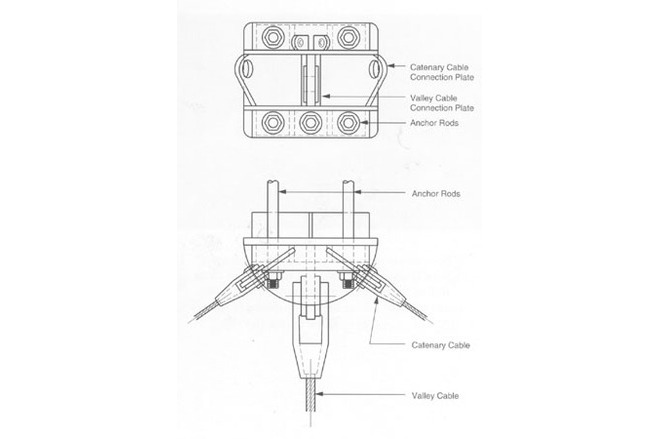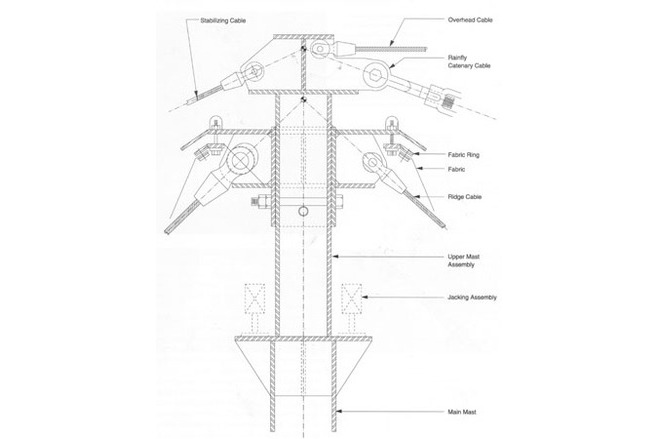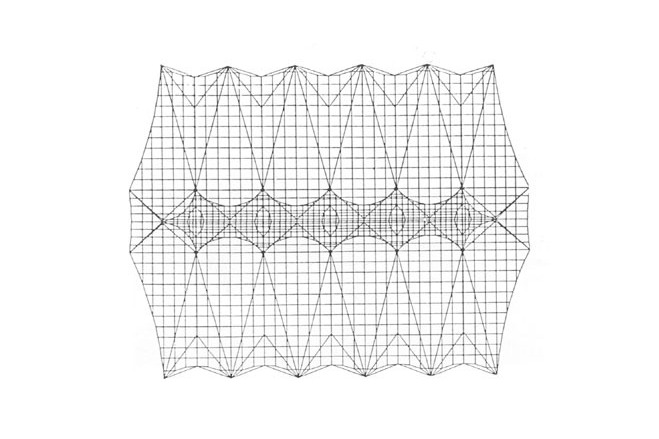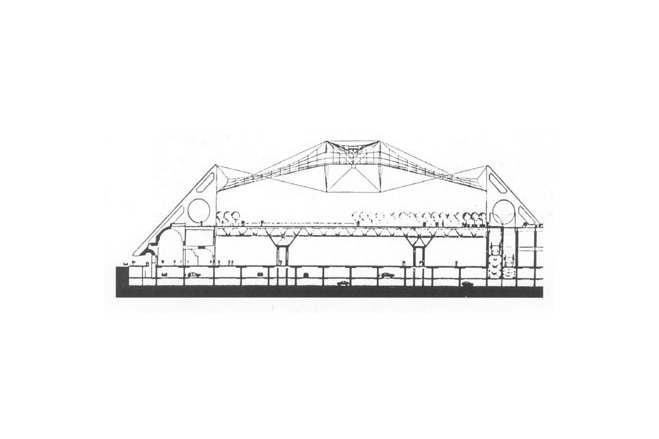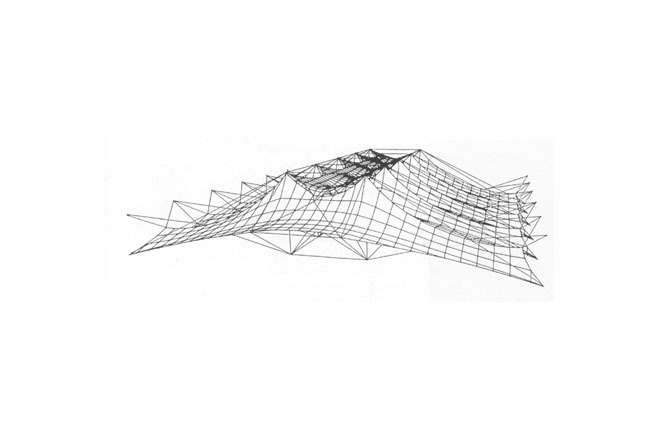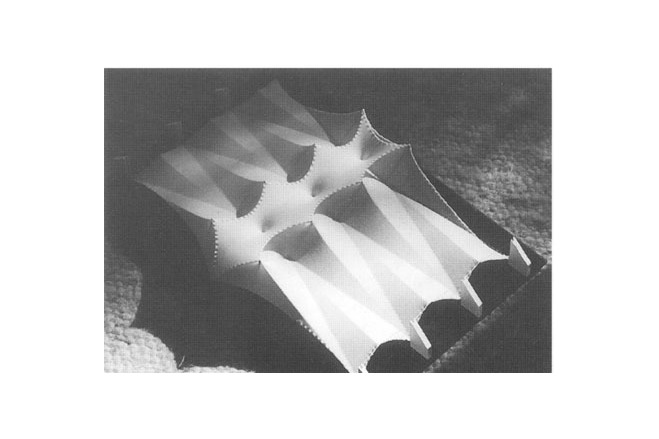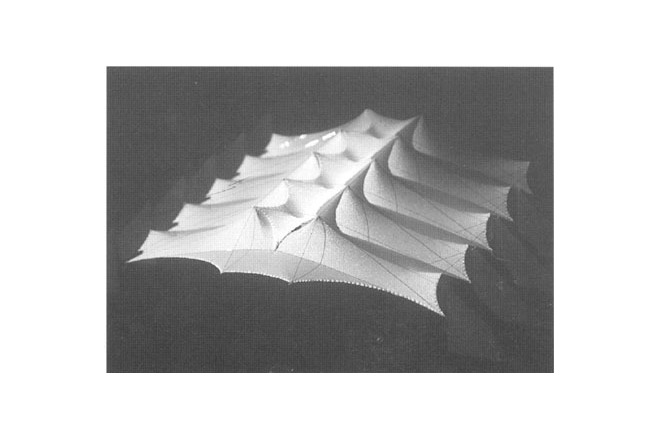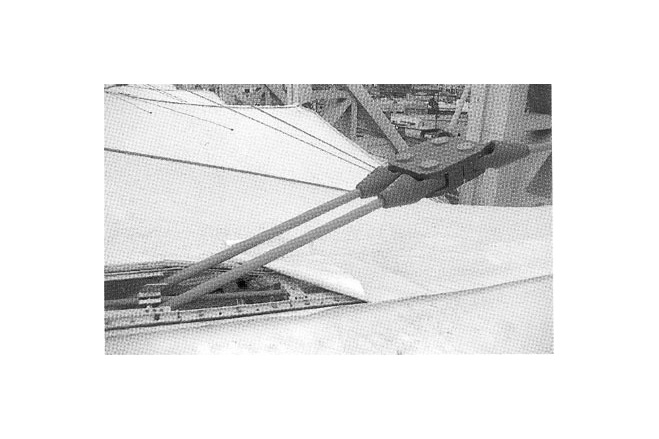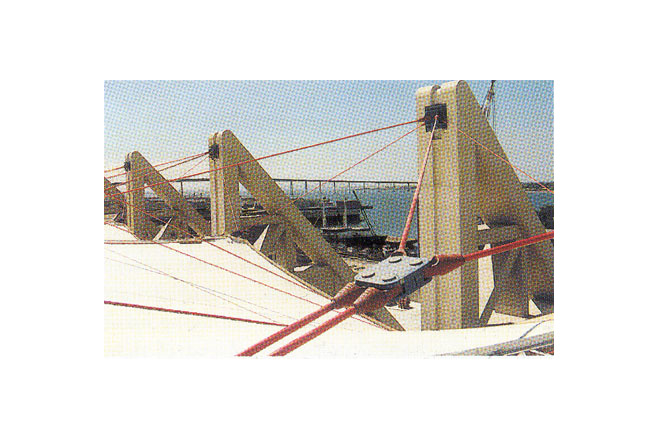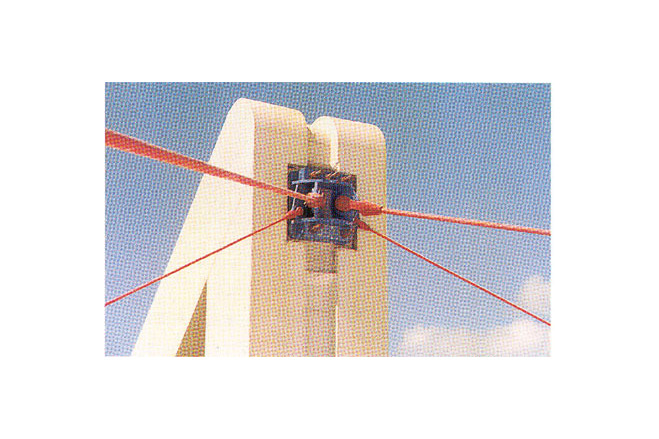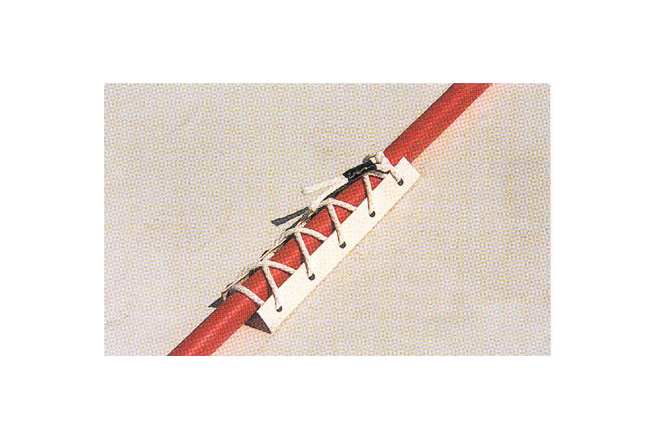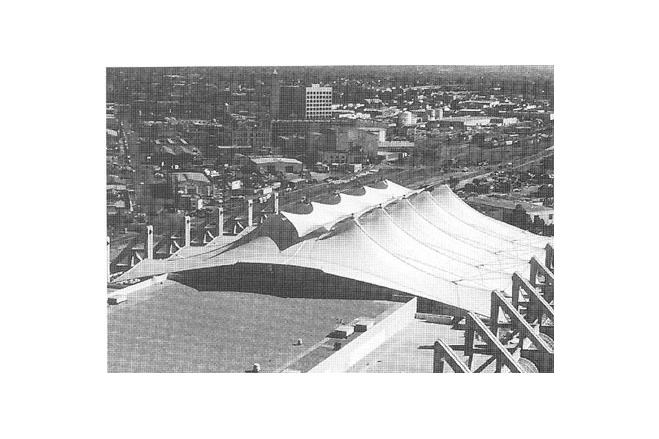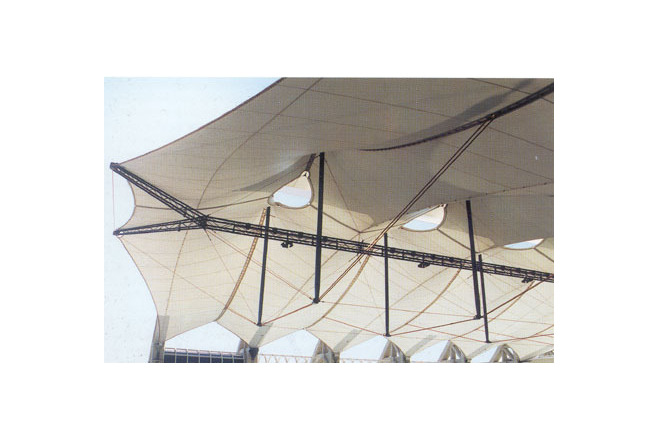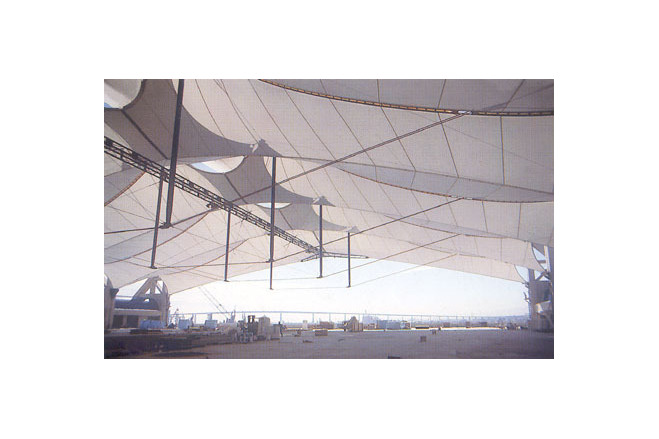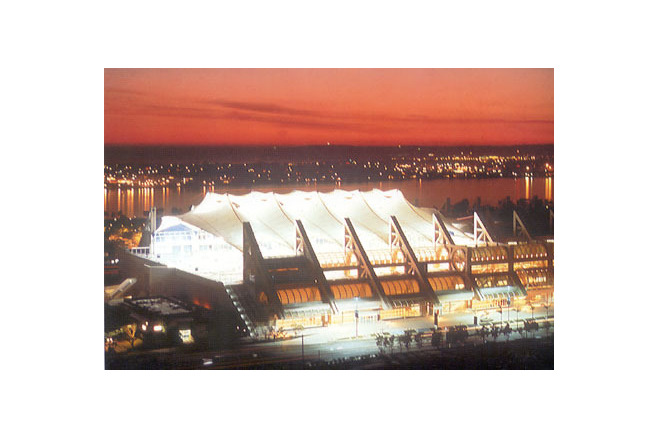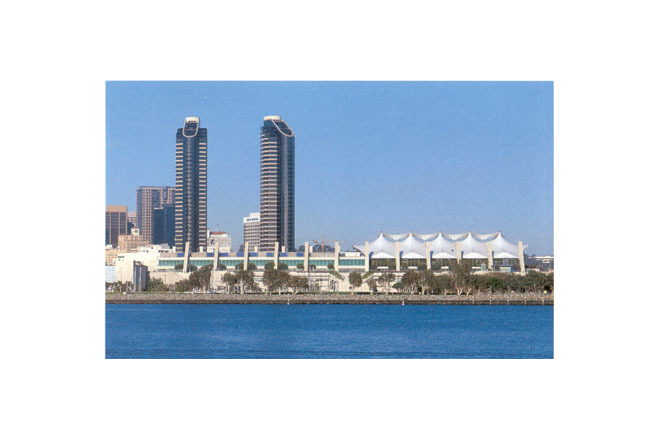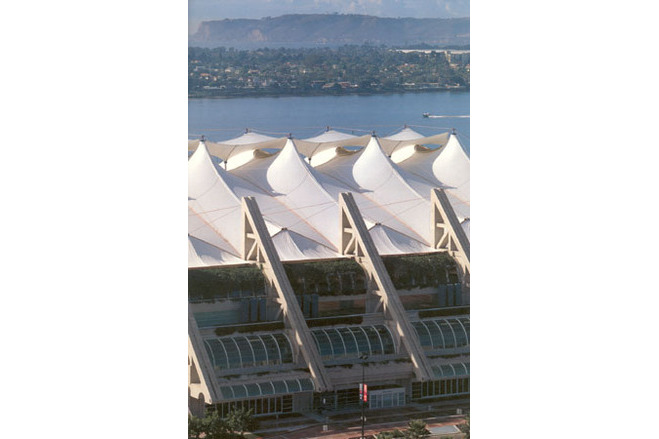Convention Center in San Diego (California, USA)
General information
-
Location address
San Diego, California
-
Location country
United States
-
Year of construction
1990
-
Name of the client/building owner
Port of San Diego, Unified Port District
-
Function of building
Office buildings & congress centres
-
Degree of enclosure
Hybrid structure
-
Climatic zone
Temperate - cold winters and mild summers
-
Number of layers
double-layer
Description
Design
At the seaport of San Diego, the architect chose a membrane roof reminiscent of sails as a meaningful and appropriate landmark. It covers 9000m² of exhibition area on the otherwise open uppermost floor of the new exhibition and conference centre. The four-storey building, with main exhibition and conference rooms of 23000m² on the ground floor, is situated at the edge of the city centre directly on San Diego Bay.
The main structure was erected in conventional construction, and large, sculptured, triangular buttresses support the membrane roof 10 to 30 m above forming a dominant architectural feature. Originally planned as riveted steel girders with allusions to historic harbour structures, they had to be executed in reinforced concrete due to problems of fire protection and building costs. The architectural concept was developed in the office of the architects Arcthur Ericson & Partner; the roof concept and the structural planning originates from Horst Berger & Partner consulted later in the design process. By the time Berger & Partner was called in the general structural concept was already worked out: a membrane roof supported by flying struts suspended between external concrete buttresses.
Description of the environmental conditions
Roof structure
The membrane roof consists of six bays, which span unsupported over the entire width between the concrete buttresses (91,5 m). The inside bays are 18,3 m wide, which corresponds to the distance between the buttresses; they are displaced, however, by half a bay width, so that the valley cables are in line with the buttresses while the flying struts and ridge cables are positioned on the centre line between them. Both end bays are held by edge cables and overshoot the last buttresses by 9,15 m.
In the main membrane, eye-shaped ventilation openings are placed at the centre of each bay between the high point struts. Above them a continous secondary membrane acting as rain protection is suspended from the tips of the flying struts of the main roof. Its low points, which are tied down to the middle of the valley cables of the main roof, serve at the same time as drainage onto the main membrane, where the rainwater runs off along the valley cables.
The flying struts and the main supporting cables holding them as mentioned lie on the centre line between two buttresses. These double cables penetrate through the roof skin, bifurcate and proceed to the top to be joined to the two adjacent buttresses. The ridge cables are arranged over the main supporting cables; they are joined with the flying struts at their upper tip and proceed to the outside building edge, where they fork out in a V-shape into two edge cables which are anchored in a similar way in the buttresses. This cable system together with the membrane transfers the vertical loads from self-weight and nominal roof load. The valley cables which together with the bifurcating ridge cables are fastened on the buttress axis 5 m above exhibition level transfer the vertical/uplift forces from wind and prestress.
The mast tips are joined with each other and with the lower anchor ponts to the buttresses through a system of afety cables lying above the membrane. These cables hold the masts in case of a catastrophic failure of the membrane, serve as assembly aids and hold the masts in position, before the membrane is installed or in case of a later replacement of the membrane. In addition they stabilise the structural system and prevent a slackening of the structural cables under extreme wind suction.
At the open ends, where a guy against the buttresses or onto another edge structure was not possible, a horizontal compression strut is used, extending over the entire length of the roof. It has forked ends to carry the horizontal forces in longitudinal direction of the building and to balance them over the entire building length. The edge cables are anchored here at the fork ends. An additional vertical guy is not available either. The long compression strut is suspended from the tips of the flying struts via short hanger cables and guyed for stability onto their lower end.
Load
The design wind speed is 31 m/s (112 km/h); the wind loads were determined in a wind tunnel test. The roof also designed for a vertical roof load of 12 lb/sq.ft. (0,58 kN/m²), required according to the building code.
General comments, links
Steel
For the steel structure the following material grades were used: rolled steel sections and steel flat are structural steel ASTM A36, tubes are ASTM A53. The high-strength bolts used correspond to ASTM A325. The flying struts consists of steel tubes (CHS Ø457,2 x 9,5 mm, l=18,2 m). The horizontal compression truss, extending over the entire length of the roof has a square cross section (a=0,9m, with chord tubes Ø 168,3 x 7,1 mm and diagonals Ø 48,26 x 3,68 mm) and forked ends (chord Ø141,3 x 6,55 mm and diagonals Ø42,16 x 3,56 mm). All tension members (main structural cable Ø47,6 and Ø 54 mm, ridge cables Ø28,6 and Ø19 mm, valley cables Ø50,8 and Ø28,6 mm) are galvanised spiral strands to ASTM A 586 and are equipped with a PVC-sheet as additional corrosion protection due to the highly corrosive atmosphere by the sea.
Membrane
The roof membrane consists of Shearfill, the PTFE coated-glass fibre fabric by Chemfab. Along the sides in front of the buttresses the membrane is connected with the Y-branches of the valley cables. Due to the large forces very flat edge cables result with a horizontal span of 9m. The membrane is joined with the edge cable via a clamped edge of aluminium strips and by aluminium straps positioned at regular intervals. Along the edges a cold-worked aluminium sheet (t = 9,5 mm) is clamped onto the roof membrane and serves as a gutter.
At the top of the flying struts, underneath the fixed connection of the external security cables, the membrane and ridge cables are fixed on a movable prestressing element, guided along the mast tube. Before the membrane is connected, it seperates from the ridge cable and is clamped to a seprately prestressable steel ring and connected there via a boltrope.
The cables meeting at the membrane corners are fastened through fork fittings, in part adjustably, to a welded steel plate assembly, anchored in the concrete buttresses by anchor bolts. The membrane there has a circular cut-outs reinforced with a fabric patch. Due to the large membrane forces a lightweight corner cable is provided, which is connected onto large edge cables with light cable fittings. A movement of the membrane parallel to the edge cables is prevented through a swaged cable clamp.
Assembly
The cable system, including the flying struts, was erected first, independent from the membrane. The membrane panels, extending from one ridge cable to the next and from the buttress edge to the centre line, were laid out on the floor, finished, raised and fastened to the ridge cables. The valley cables were laid out on their membrane reinforcement along the centre of each membrane element and fixed in position through a short lacing. The prestressing of the main membrane is accomplished by jacks, set onto welded support brackets; they jack the movable mast head up which is then secured by a pin.
[Soft Shells, Hans-Joachim Schock, p128-131]
San Diego Convention Center
Birdair Tensioned Membrane Structures
Light Structures, Structures of Light: The Art and Engineering of Tensile Architecture
Convention Centre, San Diego, California, USA
Material of the cover
-
Cable-net/Fabric/Hybrid/Foil
Fabric
-
Material Fabric/Foil
Fiberglass
-
Material coating
PTFE
Main dimensions and form
-
Covered surface (m2)
8400
-
Total length (m)
91.5
-
Form single element
Anticlastic
Duration of use
-
Temporary or permanent structure
Permanent
-
Design lifespan in years
11-20
Involved companies
-
Architects
Horst Berger & Partners
-
Contractors
Editor
-
Editor
Marijke M. Mollaert


